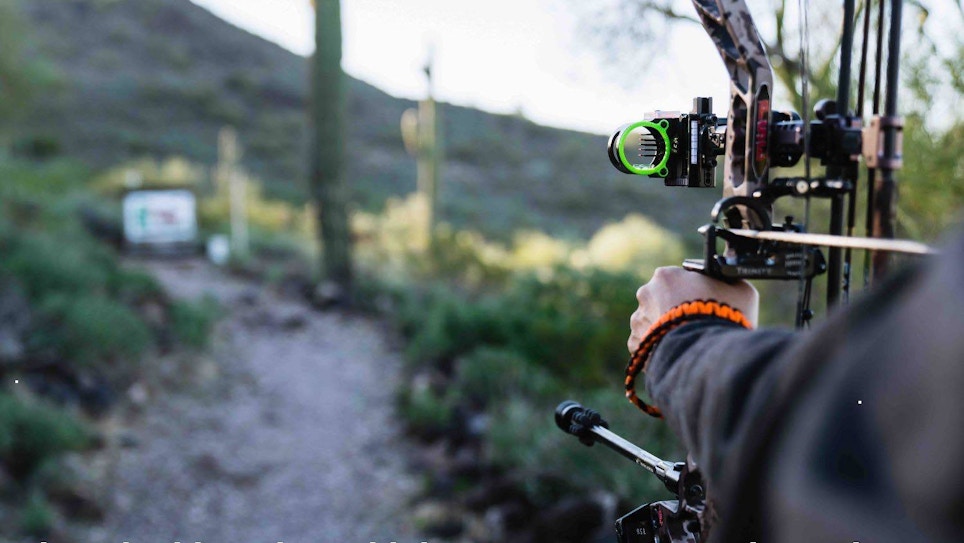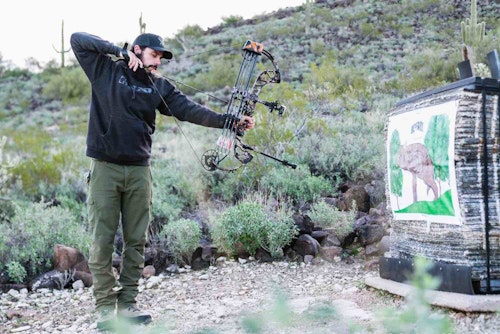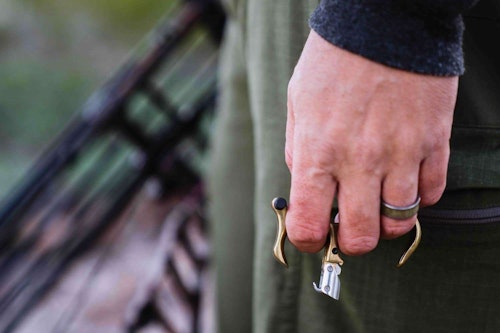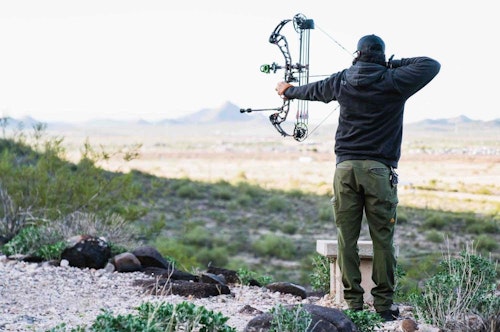
Perhaps no two words scare bowhunters more than “target panic.” The reason is target panic can affect anyone, and it’s usually difficult to beat.
There is nothing like it — pulling the string back and letting it rest on your face. Glaring through the peep sight and floating your pin over its mark. And with slow deliberate pressure, it happens. The arrow leaves and cuts a path through the air, arcing into the bull’s-eye.
Whether you’re aiming at a target or an animal, it doesn’t get much better than seeing your arrow hit its mark. It’s when all of that hard work you’ve done tips its hat to you.
The road to that point, however, can be one with many bumps and turns. Be it target panic, punching the trigger, bow tuning issues, or even lack of practice. Nearly all shooters experience roadblocks that stand in the way of accuracy. With dedication, though, any shooter can break through those roadblocks and keep stacking arrows in the soft spot of that target, or clean through an animal’s vitals. There is always a reason a customer’s arrows don’t hit their mark.
1. Target Panic
Nearly every customer who walks into your archery shop has struggled with target panic at some point. In fact, I’ve never met someone who hasn’t dealt with it in one way or another. Target panic is 100 percent a mental demon that infiltrates the minds of archers and bowhunters far and wide. And unfortunately, it often strikes those archers who shoot the most the hardest. It has a few different forms, but they all have one thing in common: each one of them is a sort of mental panic. That panic creates inconsistency on the archer’s part. That inconsistency behind the bow means inconsistency downrange.
For some, they can’t put their bowsight pin on the bull’s-eye. Their mind won’t let it happen. It feels like a weight holding down their bow arm, keeping it from going where it should. For others, there is an anticipation of the shot. A flinch that happens. Picture someone behind a rifle that they think is loaded. When they pull the trigger, there is often a flinch for their anticipation of the gun going boom! The same logic goes for shooting a bow.
I’ve dealt with this kind of target panic, and it’s not fun. The dents in my brick wall out back are proof of it. And then there are those who cannot let down once they’ve drawn back. They need to send the arrow regardless of wind, their form breaking down, etc.
I’ve got a friend who struggles with this form of target panic. The result is often broken down shots with many “fliers.” Not a good recipe for the consistency that builds confidence for the field.
What to Do?
The good news is target panic can be beaten. It is 100 percent mental. When coaching a customer, explain to them that in order to break target panic, they need to break their mind. Unfortunately, this isn’t something that can be done overnight. It’s not as easy as buying some new gadget that will cure them. Beating target panic is a long game. With dedication though, they can do it.
- Blank Bail Shooting – This is when the shooter stands or kneels mere feet from a target and shoots into it with their eyes closed. It takes aiming out of the equation, which is a big contributor to target panic. Just focus on getting a nice clean release without worrying about where the arrow goes.

- Take Off Your Sight – By taking off your sight, you’re also taking out that aiming element we just discussed. Focus on form and shot execution. Stay fairly close to the target for this or use a very large target.
- Consider a Hinge or Tension Release – The upside of using a hinge or tension-activated release is they both promote getting a surprise shot. If used properly, these releases can help break down those mental demons and squash shot anticipation. This is not an immediate fix, but a great tool to help along the way.
2. Punching the Trigger (Command Shooting)
Plain and simple, we are control freaks. Our daily lives have shaped us this way. We are in the driver’s seat for things like when we eat, sleep, workout, bathe, etc. To not be in the driver’s seat for when an arrow is released would severely go against that. This explains why most archers don’t let a shot happen, they make it happen. This level of thinking results in what’s called “punching the trigger.” It varies in intensity, but it’s when someone is deliberately smashing the trigger with their finger or thumb and forcing the shot to go off. This works for some people and they shoot great. However, for most it makes consistency a struggle. Ideally, we want to relax, let the pin float over the bull’s-eye, and let the shot go off from a gradual execution on our part.
I want to clarify something here: It is my belief that punching the trigger/command shooting and target panic are different things. While punching the trigger can be an element of target panic, someone can absolutely punch the trigger and not have panic at all. There are professional archers who punch the trigger and win tournaments regularly. Issues can arise though, because this is very difficult to replicate time and time again.

What to Do?
Punching the trigger is far from the end of the world. As I said, some do fine with shooting this way. For those who don’t, though, there are a few things you can try in order to change your process. And in order to not punch the trigger, changing the process is the ticket.
- Blank Bail Shooting – Just like discussed above with target panic, blank bail shooting is a great way to focus on getting a nice clean release without the distraction of aiming. Aiming is what will make you punch the trigger as the pin gets closer to the bull’s-eye. Don’t worry about your impact point, though. Consistency starts before the arrow is released.
- Tag Team – It really pays to know what a clean release feels like. From that we can replicate it as well as know when it doesn’t happen. A great way to do this is by having your customer come to full draw and then you engaging the trigger for them. Have the shooter give you the okay when they’re steady on target and you can set off the trigger whenever you see fit. The shot will surprise them, as it should. And so will the dead center arrows.
- Learn A Release Aid – There is a right way to operate a release aid no matter the style. It should be in your customer’s best interest to learn how to do so. None of them involve punching a button or trigger. A shooter must take the time to get trained up to watch their groups shrink.

3. Bow Tune/Arrow Setup
An acquaintance of mine just recently got into bowhunting. The guy has become a maniac for the bow life and was so excited recently to tell me about his new arrow setup. So, after he tells me what he went with, I asked, “How did they tune?” His response was “Is that when you move your sight?” My thoughts were, Ah, to be young again.
To his credit, there are a surprising number of folks who have no idea what bow tuning is or how to do it. A shooter doesn’t necessarily need to know how to do it, but they do need to be aware of it.
Along with the speed bumps one might have to tackle dealing with their shooting technique, consistent accuracy is also influenced by the tune and arrow setup for their bow. As you know, if a bow isn’t tuned, then you can’t expect it to perform to its fullest.
A well-tuned bow is one that’s shooting an arrow straight and true. Arrows that come off the string and rest slightly off-center are ones that won’t have consistent flight. They’ll plane up, down, left or right, which doesn’t bode well for tight groups downrange, not to mention good broadhead flight. And those arrows will never tune right if they aren’t properly spined. Arrow setup matters for consistent accuracy.
What to Do?
- Pay Attention to Arrow Flight – Good arrow flight is an indication of a well-tuned bow and properly spined arrows. Arrows that group well together downrange with both field points and broadheads is the goal. Watch your customer shoot: Are their broadheads not grouping with their field points? Are their arrows dead-center at closer range, but off-center at longer range? Are their arrows sticking out of the target crooked? If the answer is “yes” to any of these, it’s time for a tuneup.
- Start Somewhere – There is a laundry list of different variables that come into play when tuning a bow and several ways to influence arrow flight. You don’t need to know how to do them all, but knowing a few simple ways to tune will do you well. Both paper-tuning and walk-back tuning are relatively easy ways to get set on a path towards success. This is assuming that everything on your customer’s bow is sound and set up properly, of course (proper arrow spine, good cam timing, no nock pinch, etc.). Of course, for proper arrow spine, archery companies have their own arrow spine charts for reference. At the very least, these are a great starting point.
- It’s Ok to Ask for Help – For many customers, tinkering isn’t their thing, and that’s where you come in to help get beyond a roadblock. Assure them there is nothing wrong with asking for help. Encourage customers to bring their bow down to your shop and have you guide them in the right direction with tuning and arrow setup. I say “guide” because the customer still needs to be the one who shoots their bow through the tuning process. The reason being is everyone shoots a little differently. The way you grip a bow, among many other things, has an influence on arrow flight. Bottom line, the bow needs to be tuned, but it needs to be tuned to the customer, not you or someone else.

4. Lack of Practice = Lack of Consistency
We’ve all got one — that buddy who waits until a few weeks before archery season to pick up their bow. Finally, they join you at the archery range and, wouldn’t ya know, they end the day frustrated and baffled. “Everything was fine the last time I shot,” they say. Then they inevitably end up blaming their equipment and spend a whole bunch of money trying to fix the problem. In all reality, the only one to blame is themselves. New archery equipment can’t fix lack of practice.
As you know, shooting a bow accurately and consistently is all about repeatability. It’s about being able to do the same thing over and over again. Same grip, same anchor point, same release. All of these things have an impact on where the arrow ends up downrange. And the only way to hone them is through dedication. The more a customer shoots their bow, the more in tune with themselves they become. Things that went unnoticed are suddenly noticed and their arrow groups will tighten with time. There needs to be consistent practice on a shooter’s part for consistency downrange.
What to Do?
- Create a Routine and Shot Sequence – Encourage a customer to set time each day when they grab their bow to shoot a few arrows. Suggest that they set reminders on their phone. When they’re behind the bow, have them create a shot sequence, something like “grip, draw, anchor, bubble level, aim, relax, pull.” Every shooter can create their own sequence and then run with it.
- A Little Goes a Long Way – When a bowhunter does practice, they don’t need to shoot 100 arrows every time they’re in front of a target. There is a such thing as shooting too much, and that can do more harm than good. Remind your customers: Even if it’s just a dozen arrows a day, a little goes a long way. Consistency over volume.
- Challenge Is Key – Getting caught up in monotony is a great way to not progress. In order to push forward, all shooters need to push themselves. For example, if you have a customer who is a 20-yard Jedi master, encourage them to leave their comfort zone and challenge themselves. Suggest that they shoot in different positions, inclement weather, and at random distances to name a few. The more discomfort they can navigate through now, the more comfortable they’ll be in the future, which means more arrows in the X.
Final Thoughts
Show me an archery customer who doesn’t want to be more accurate and I’ll show you a liar. Call it primal or call it just satisfying. Arrows stacked in a bull’s-eye equal confidence at the range, which equals confidence in the field. Getting to that point, though, doesn’t happen overnight. From top to bottom, this stuff takes dedication and attention to detail. These are just some of the building blocks that go into better accuracy. With the passing of time, your customer can eventually build an untouchable fortress brick by brick, and arrow by arrow.
Photos by Josh Kirchner





